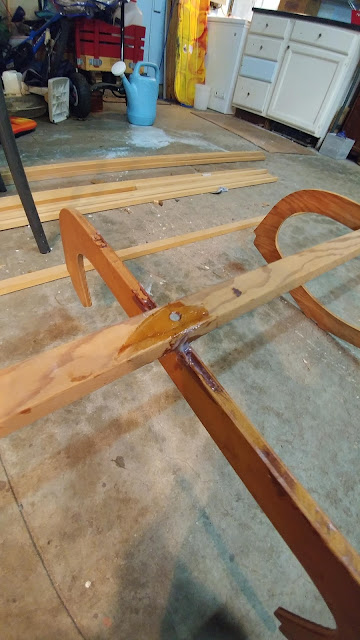Just Stringing You Along From Stringers to Strings.
I haven't posted in a while and a few people have been wondering what is up. This summer Myles and I have been fishing a bit and he has been using his Mom's sit on top Kayak. I decided it was time to go ahead and build him one of his own after all he is starting to get too big to sit and just ride along. First I looked at Yostwerks. I highly recommend Tom's boats. I built a Sea Tour about 10 years ago
I'm building a Canvas Back Kayak. Here are the plans for those interested. This came from an old Mechanix Illustrated magazine. My brother ran across someone selling a pile of already cut out kayaks a few years back and he assembled one but has had limited success with his canvas skin. We took it out this summer and it is far more stable than my kayak, a plus for a young child in my eyes. After about 30 minutes, the water started soaking through the canvas in my brother's kayak and we came back. I'll do a clear vinyl skin on the one I'm building so this won't be a problem. If I didn't already have the precut parts here though I'd be building a sea bee. Plus the price is right. LOL beware of the free boat right...
Here is one of the stringers. I pin a screw through it and I'm using West System 10 to glue everything together. I'm finding I really like the pre-measured caulking gun tube stuff. It is easy to use and mix up and seems just as strong as my pump bottle stuff. Plus it is easy to reseal.
This is the stringer your back will lean against in my experience if any place on a Kayak will break this is it. I've broken mine here before. Something about a 3-4 ft wave breaking as you crash into the beach does not do well at this point. So I have doubled up the thickness of this stringer and laminated it together. There is still quite a bit of cleaning up to do on this.
To increase my strength and because I don't trust glue and screws alone I lash my keels to the stringers. Here is a final cleaned up joint. Later I'll go back and soak the nylon line with a coat of epoxy to add even more peace of mind.
Here we are now just waiting for the epoxy to dry before the next step.
I've strung you along enough, now back to the Typhoon. This is a quick simple project that I've put off far too long. My mast head spinnaker sock needs a new line preferably one that won't jam when the sail is up. I purchased this set up some years back on eBay. I think it came off a Cal 22 or a Catalina who knows but it works pretty well and it the perfect size for the Typhoon. The problem is it came with a twisted nylon line which the brindal for the spinnaker sock has been spliced to. This is okay and probably worked great when it was first done but recently It's been catching and getting stuck so I've decided to replace it with a piece of double braid line.
The hope here is the double braid will be smother and less likely to jam.
Here is where the problem lies the bag bridal should come up through this block at the top of the sock as shown but it keeps jamming when it is time to take the sail back down again so I end up releasing it at the halyard which usually means I'm bringing a sail home to dry.
No problem here I can walk to the other side of the garage unjam it and pull it down. Out on the lake though it's a lot harder to walk up the mast.
Time to pull the old apart and grab the rope splicing kit. Previous owner threw this in when I bought Kraken and it has come in handy several times.
I've found these knitting needles are super for stuff like this. I put the bridal into it then tape the line inside before I start to weave it into the double braid.
Next I work it through the casing.
In and out and in again.
Then some more.
After I have that done I took a piece of sail tape and encapsulated the whole thing. My thinking is this will help eliminate any catch points and provide a chaffing guard to this part of the line.
Next I whipped the ends of the bridal and line to further eliminate potential catching points and also stitch edges of the sail tape down should the glue come lose in the future.
Next I ran the line back through the bag and measured and cut it to length. Followed by a little torch work on the ends.
Then I whipped also for good the ends for good measure.
I repeated the same process for the sock down hull side as well. Next time I think I'll make the down side a different color than the hoist side so I know which line is up and which is down. Lots of thought goes into these projects about how it could be better if ..... as you do them. Happy sailing and hope to be out on the DN soon.




















Great photography Chris; it helps to see what and how you are doing these things. People with much less skill, like me, need that. Great work space too!
ReplyDeleteThanks I'm just fumbeling through. I'm sure a pro rigger is out there shaking their head.
Delete